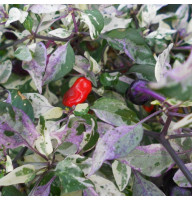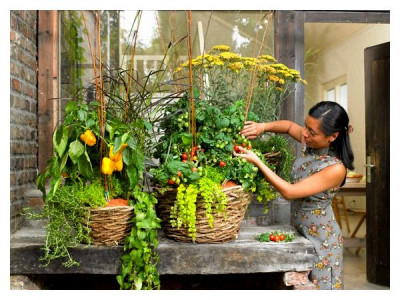The principles of cultivation are similar to bell peppers, but it is still better to talk about chili separately, since there are certain nuances in agricultural technology. Chili is extremely worried about stagnant water, high groundwater levels, extreme heat and sunburn, as well as water getting on the leaves and stems (the sprinkling method when watering is undesirable).

Chili pepper sowing dates
It’s worth starting to sow at the beginning of February, but if you last until March, there’s nothing to worry about. If you illuminate the seedlings with lamps, then you can sow peppers in early January, and after 2 months you can transplant the seedlings into pots, and it is no longer necessary to illuminate them, and in May - June the seedlings will turn into ornamental plants with bright, beautiful fruits.
Preparing pepper seeds for sowing
No one can guarantee that the seeds will sprout perfectly. However, there are ways to influence the situation: disinfect, soak... We disinfect the seeds in a solution of hydrogen peroxide - 1 teaspoon of undiluted solution, hold the seeds in it for 20 minutes. Or soak the seeds in homemade vodka, also for 15-20 minutes.
Germination
This method is chosen by those who want to quickly see seedlings or test old seeds for germination. But keep in mind that germinated seeds will need to be sown only in moist soil, because they may die in dry soil.
Hot pepper seeds can sometimes take up to two months to germinate; there are such incidents. The main version is stale (old) seeds. But this is not always the case. I had one case when I needed to check the germination of hot pepper seeds that had been in my storage for probably 5-6 years. At first I wanted to throw it away, and then, out of curiosity, I wet two cosmetic cotton pads, put the seeds between them and put them on the shelf for germination. And after 5-6 days they got together)).
It turns out that a lot depends on the variety; there are such slow-witted ones that they take a long time to germinate fresh or their germination is constantly low. I practice seed germination when the seeds are very valuable or there is only one seed of the desired variety.
The method is very simple, take two cosmetic cotton pads, wet them, and squeeze out the excess moisture. Now we take the seeds and soak them first in undiluted hydrogen peroxide for 20 minutes, or you can just do it in vodka, but after the vodka, the seeds must be rinsed with clean water, but after the hydrogen peroxide there is no need to rinse.

Place the prepared seeds on a damp cotton pad and cover with another damp pad on top. Next, put the cotton pads with the seeds inside in some jar or other shallow container, preferably with a lid, close the lid and put the seeds on a shelf where there is light. Instead of a lid, you can use cling film. It is advisable to label the jar: the date the seeds began to germinate.
Every day we open the lid, also open the discs and look at the condition of the seeds. We ventilate for a couple of minutes, and if the cotton pads are dry, then slightly moisten them with a spray bottle. You can use water with epin or phytosporin, but I use plain water.
And we repeat this until the seeds begin to hatch (the tip of the white root appears). If a seed sprouted, I immediately try to plant it in a small plastic cup with peat (no need to wait until the root grows larger), and leave the rest of the seeds to germinate. And so on until most of them germinate. It happens that all the seeds germinate together. And it happens that together they don’t want to peck.
I have a rule: do not keep seeds germinating for more than ten days, because they can be spoiled (they will begin to rot from moisture or become moldy). If the seed does not want to hatch within 10 days, then I soak it in a phytosporin solution and sow it in small cups with soil. Such seeds may well still sprout, you just have to be patient, so there is no need to rush to throw them away, because not all the mysteries of nature are known to us.
Soil for indoor peppers
It is best to sow hot pepper seeds in a substrate of high non-acidic peat or coconut soil. And seedlings with the first pair of true leaves can be planted in any purchased universal soil with a neutral reaction; acidic soils are not suitable for hot peppers. Soil for seedlings can be prepared yourself from high-moor non-acidic peat, humus (vermicompost) and river sand. It can also be made from turf soil and river sand (soil from the forest).

Planting adult hot pepper seedlings in the garden
To avoid cross-pollination, hot peppers should not be planted together with sweet peppers. Hot peppers, the seedlings of which have reached 12-15 cm, and whose appearance indicates normal development, are ready for transplanting. In a permanent place, adult seedlings can be placed in a greenhouse or a greenhouse under agrofibre. Also, you can always organize high beds for pepper, where it will be more convenient to grow the crop.
Before planting in the ground, seedlings must be hardened and accustomed to the sun: taken outside in warm weather, leaving until evening. Thanks to this, the peppers will become stronger and it will be easier for them to withstand the night cold after planting in open ground.
Hot peppers grow much better in a greenhouse, where there is a constant temperature and humidity levels are maintained. In open ground, where conditions can change several times a day, pepper grows weaker and the yield will be lower.
In the most suitable conditions, the hot chilli pepper can grow into a large subshrub, up to 1.5 m high, and produce many high quality fruits.
Fertilizers for chili peppers
Experts say that the fertilizers contained in the soil are sufficient for hot peppers. But you can always support the growth and development of plants with complex fertilizers, which are applied with each watering at the root (or leaf) every 2 weeks. Fertilizing with diluted chicken manure will also help.
Watering hot peppers
Watering should occur as the soil dries. Do not overwater the pepper or let the soil dry out until it cracks. Watering should be done with warm water, not during the brightest sun, so as not to harm the root system.
If you are growing chili peppers in pots, watering can be done in small amounts up to twice a day or using self-watering systems. The plants themselves can indicate a lack of watering by dropping their leaves.
Hot pepper rooting cuttings
It is necessary to have a healthy mother plant from which to take cuttings for rooting. Plants grown from rooted cuttings completely replicate the parental forms.
It is best to root green cuttings in water:
We place the cut cuttings in ordinary water (without roots and other chemicals), add water rather than change it, put a jar or bottle (preferably dark glass) with water in a warm and bright place (out of direct sunlight). We wait a month, observe the appearance of roots (at least 1-2 cm) and plant them in a cup with soil.

Transplanting adult pepper bushes:
At the end of the season, you can dig up a hot pepper bush and transplant it into a pot to take it home for the winter. It should be remembered that the survival rate will be 50x50.
I tried to replant in every way... both with my own lump and with cleaned roots, and with pruning of branches and roots, and without pruning as is, and with growth stimulants, etc. No matter what, hot peppers are accepted if they want to be. Therefore, recently I have been practicing replanting in a minimum volume (I look at the size of the root), usually it is a pot with a volume of 1-2 liters (very rarely more). If the bush is accepted, then transferring it into a large container will be as easy as shelling pears. And if not, then throwing it away will also be easier.










